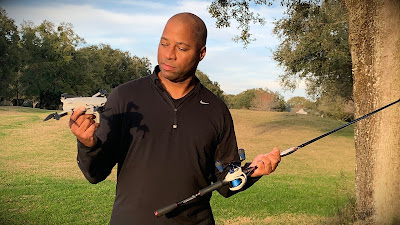Trust me, that’s not click bait! It’s real.
The Full Story
It’s been cold here in Florida, relatively speaking of course, the past few weeks. So I had some time to catch up on watching some of my favorite YouTuber’s. And I stumbled on a video that, wouldn’t you know it. low and behold, made me think that I’ve “likely” been breaking Federal laws! A state that I didn’t want to be in for obvious reasons, and one where the corrective action I needed to take would cost me $160 and 15-20 hours of my time. Please, let me explain.
As you know, I enjoy kayak fishing and making films/videos about it for YouTube. I call it a hobby, however, others may view it as, and I quote, “the furtherance of a business”. There’s some truth to both viewpoints. When I started kayak fishing and filming it and posting my videos to YouTube, I simply enjoyed the pleasure of it and the learning experience of creating videos and posting them. And, of course, all YouTuber’s would like to see their channels grow….that means people like you watching, commenting, and liking every video. At some point, if your channel does manage to grow, you will gain enough watch hours and subscribers to apply to be in the YouTube Partner Program.
YouTube Partner Program (aka Monetization)
Why would anyone want to join that program? Well, honestly, because kayak fishing and filming is expensive. For example, GoPro Cameras alone are $300-$400 each and some of us have 3+ of them, not to mention all of the storage cards, batteries, computers capable of editing, oh, and a drone…., etc., etc. …. you get the picture. So why not join that program and have YouTube place advertisements from their network on your videos and recoup some cash with a revenue split that YouTube/Google offers you? Who wouldn’t want that since you’ve put in likely a year or so to even get to that point.
The Line is Crossed
Ok, so somewhere between starting to kayak fish, film it, posting videos on YouTube, being accepted into the YouTube Partner Program and monetizing those videos, and recording scenes with a drone along the way, the proverbial “you” crossed the line drawn by the FAA (Federal Aviation Administration) between recreational flying and needing to become a full on FAA Remote Aircraft Pilot. That’s right, the Code of Federal Regulations (CFR Title 14 Part 107) that deals with small unmanned aircraft systems (sUAS) states that you must become a certified licensed aircraft pilot with the FAA. Why? Because you’re using a drone in the “furtherance of a business”. There’s that pesky phase again.
Interestingly, most reasonable people would say that the line was crossed the day we were accepted into the YouTube Partner Program and turn monetization on for your channel. But, technically, in the eyes of the FAA the line was crossed much earlier. What I mean by that is that you do not have to make money (and mind you we’re not talking about making a profit, just simply making money) in order to use a drone in the “furtherance of a business”. Technically, to the FAA, you likely crossed the line when you started using a drone to film and post aerial footage on YouTube…again, in the FAA’s parlance.
But, I See Lot’s of YouTuber’s Doing It?
That reminds me of something my mother used to tell me. If James, a childhood friend, jumped off a cliff….. I’ll stop there as I’m sure your parental figure likely finished the story for you too. And that’s the point, just because someone does something, does not make it right….and ignorance of the law is also no excuse. Let me back up and explain that expression as it applies in my situation.
Buying a Drone
Like many others, I looked into the law when I was first purchasing a drone. I read up on everything I could and I discovered that I’d have to “register” a drone if it was 0.55 lbs – 55 lbs (that’s up to but not including 55 lbs at launch btw). And I knew overall I had to be safe…that means don’t fly into aircraft, spy on people, etc. I thought to myself, I can get one that weighs less and I’ll never fly high enough to have to worry about anything as I’m only filming kayak fishing! So I purchased a DJI Mavic Mini which DJI conveniently made weigh 249 grams (0.548951 lbs) fully loaded. Problem solved, no registration needed, I’m a hobbyist and can now go have fun filming kayak fishing. Well, ignorance of the law is no excuse! Interestingly, I was right about the “registration” requirement, I did not need to register my Mavic Mini. But then there’s that pesky “in furtherance of a business” phrase that throws a monkey wrench into the mix. So, do you have to register a drone weighing less than 0.55 lbs (in the USA) no… at least not yet. But, do you need a Small Unmanned Aircraft System Remote Pilot License? You do if you use a drone in the “furtherance of a business.” I found that out simply by watching some YouTube videos about a week and a half ago!
So, OK, I Need One – What Does It Take
Ready for this? You need to pay $160 in order to take the “Unmanned Aircraft Generall – Small (UAG)” Remote Pilot exam. If you pass that test with a 70% or higher grade, you can then get your FAA Part 107 remote pilot certificate. And, since as a remote pilot flying under CFR Part 107 rules must be flying a registered drone regardless of weight, you must also pay $5 to register your drone. Once you’ve passed the exam, obtained your license, and registered your drone, you are licensed to fly! Meaning, you can record footage and use it in the, “furtherance of a business”!
So what’s on the test?
You must learn all of the regulations, how to read sectional charts and know how to calculate airspace, read METAR reports, and TAFs, and TSGs, and NOTAMs, find locations based on latitude and longitude, understand “pilot speak” at airports, airport operations, how thunderstorms are formed, the effects of loading your drone, controlled airspace rules, how to inspect towers, how long after you drink you’re allowed to fly, the blood alcohol level for pilots, aspects of crew management, risk managemetn, general aeronautical decision making, etc. etc. etc. Yep, that’s all to be able to fly a drone to record kayak fishing!
It takes about 15-20 hours of studying, and for geeks like me, it’s really interesting learning. It can be quite dry, but my original motivation of “being legal” quickly turned into “being safe” and I developed a “respect and appreciation for the FAA and their attention to detail that keeps us safe when we fly.” I mean, I don’t know if I’ll ever have to fly into an airport and merge into traffic at a 45* angle on the downwind side, or compute the height I’m able to fly to inspect a tower in class E airspace … but I really am glad that I did it!
I Did It! – 97%
That’s right, I’m now (or as soon as I get my temporary certificate) an official FAA Part 107 Remote Pilot. I passed the 60 question exam with a 97%! I missed two questions and both of them are pestering me at the moment.
References
Here are the reference materials I studied in case you’re interested in becoming a remote pilot too….or in case you need some good reading material at night to put you to sleep!
You can take a course, but I didn’t. I only used the FAA materials and YouTube videos.
I’d recommend consuming the information in the following order if you’re interested:
- Watch Tony Northrup’s Video (1:45)
- Watch 12 videos (#1-12) from TheDroneCoach (various)
- Watch Better B Roll’s Video (2:25)
- Download and read the FAA’s Remote Pilot Study Guide (Be sure to check if it’s been updated. Current one is August 2016)
- Download and Become Familiar With the Airman Knowledge Testing Supplement (This is the book you’ll use in the test! Use these sectional charts to test your knowledge because that’s what the test will do!)
- Take the FAA’s practice exam
- Sign up for your FAA Tracking Number (there are videos on how to do this, it’s complicated because it’s a government site lol)
- Sign up for the test using your FAA Tracking Number (yes you’ll need to create YAA – yet another account)
- Take the practice exam here but be sure to check only the areas necessary for sUAS (by the time you get here in the list you’ll know those areas)
- Read the CFR (it should make more sense now)
- Read the Pilot’s Handbook (it should make more sense now)
- Purchase a magnifying glass and bring it with you to the test!!! Trust me on this one! I don’t wear eye glasses nor do I wear contacts but I brought some readers and a magnifying glass and there’s no way I could read the charts in the printed AKTS if I didn’t.
In Conclusion
To the FAA, thank you! What an excellent experience. I’m a safer drone pilot now and it’s all due to your regulations. As a suggestion, you should continue to do YouTube social outreach because your requirements are not well known at all and most of us are going to ignore the type of documents that the government creates!
To my subscribers and viewers….you can expect even better (aka legal) aerial footage in my videos now!!! But honestly, enough of all this license and registration talk! I’m Bravo, Echo, Charlie, FoxTrot, Whiskey’d out on that stuff! It’s time to go catch some fish! Let’s go see what we can catch!
~Kayak Fishing Addict
PS If anyone needs an FAA Part 107 remote pilot let me know (sorry for the plug but I figure I’ve gotta recoup that $165 somehow)!












Add comment